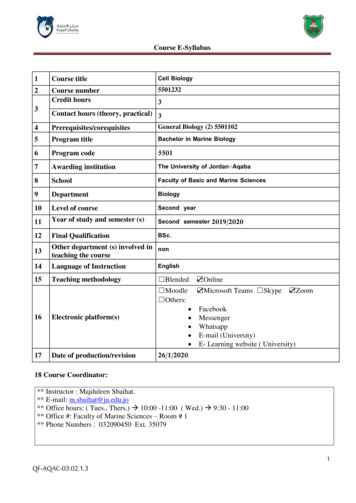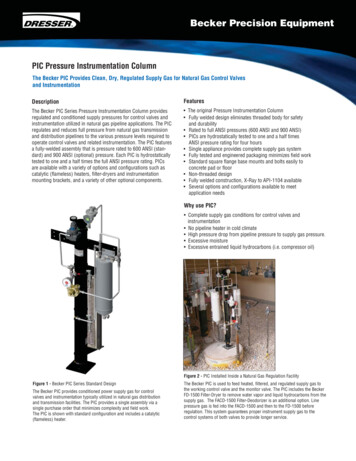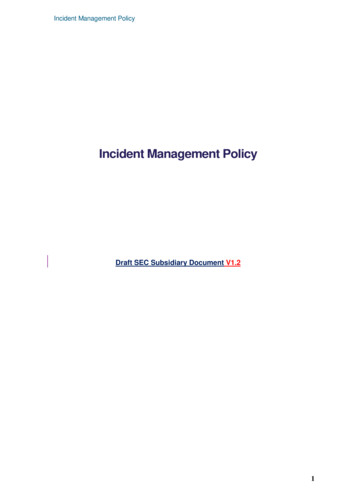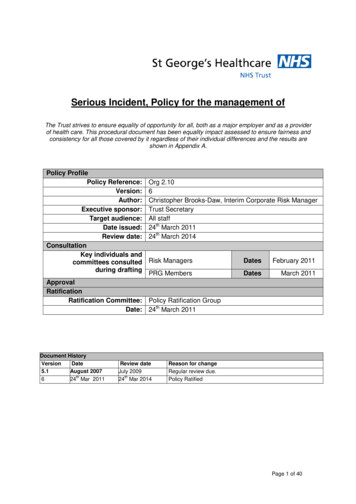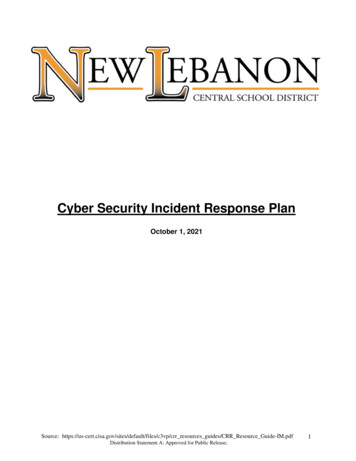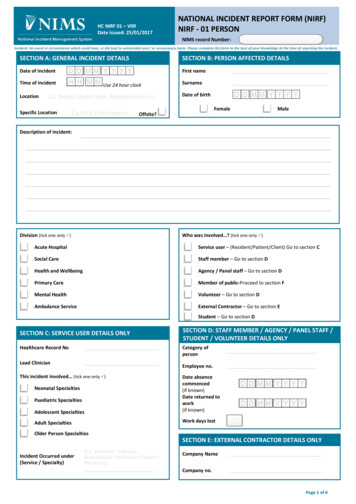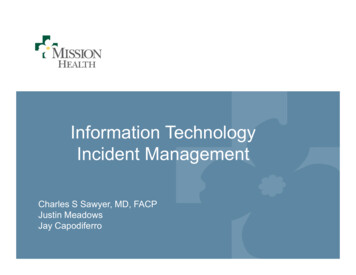
Transcription
Information TechnologyIncident ManagementCharles S Sawyer, MD, FACPJustin MeadowsJay CapodiferroIT Incident Management I Becker’s Hospital Review 2018 I 1
DisclosuresAll of the presenters are full timeemployees of Mission Health Systemand have no conflicts of interest todisclose.IT Incident Management I Becker’s Hospital Review 2018 I 2
Our BIG(GER) Aim:To get every person to their desiredoutcome, first without harm, also withoutwaste and always with an exceptionalexperience for each person, family andteam member.IT Incident Management I Becker’s Hospital Review 2018 I 3
MAP OF MISSIONHEALTHSYSTEMMAP OF MISSION HEALTH SYSTEMWestern North Carolina 18-County Service AreaPopulation (2016): 882,581Percent over 65: 22%IT Incident Management I Becker’s Hospital Review 2018 I 4
Mission Health System 6th largest health system in North Carolina and the only tertiary careregional referral center in Western North Carolina. Region’s only Level II Trauma Center 17th largest employer in North Carolina Accounting for 1 in every 16 jobs in Buncombe and MadisonCounties 1 in every 39 jobs in the 18 county service region Creates more than 1.04B economic activity in Buncombe andMadison counties and nearly 2B across the regionIT Incident Management I Becker’s Hospital Review 2018 I 5
MISSION BY THE NUMBERS*Total Patient Days235,490Total Discharges48,027Average LOS4.9Average Daily Census645Case Mix Index1.6993Total Surgery Cases46,421Total ED Visits169,648Total OP Visits475,158Total MAMA FlightsTotal Physician Visits (employed)*FY 16 as of 7/1/16IT Incident Management I Becker’s Hospital Review 2018 I 61,035537,354
IT Incident Management I Becker’s Hospital Review 2018 I 7
Incident Management BEFORE Documented in SharePoint (if at all) No cross-reference to ticketing/incoming support calls Management/leadership managed by rotating technical andapplication managers (7 resources). No categorization, reporting or post-incident follow-up RCA left up to manager or owning group Poor change management contributing to self-inflictedincidents and concurrent incidents. Poor internal and external communication regardingrecognition, updates and closure of incidents. Senior IT leadership often “informed” of incidents by otherhealth system leadership before IT even awareIT Incident Management I Becker’s Hospital Review 2018 I 8
Recognition of Need A standardized approach to incident management Standardization of:– Definitions and roles– Evaluation of incidents– Communication– Documentation– Root cause analysis– Prevention of recurrences– Identification of TrendsIT Incident Management I Becker’s Hospital Review 2018 I 9
Hospital Incident Command System A flexible, scalable, and adaptable system That can be used by all hospitals regardless of size, location, patientacuity, patient volume, or hazard type. HICS expands or contracts relative to the needs of the situation. By using HICS, hospitals adopt a nationally recognized system thatpromotes successful incident /HICS Guidebook 2014 7.pdfIT Incident Management I Becker’s Hospital Review 2018 I 10
Hospital Incident Command System Assigns positions only as determined by the scope and magnitudeof the incident In keeping with the principle of scalability, which is important duringan emergency. Staff assigned positions are returned to their normal work functionsonce their position is no longer needed for the incident ICS Guidebook 2014 7.pdfIT Incident Management I Becker’s Hospital Review 2018 I 11
Foundational Principles Predictable chain of command with a suggested span of control Accountability of position and team function, including prioritizedaction checklists Common language for promoting communication A flexible and scalable incident management system addressingplanning and response needs of any size hospital with universalapplicability Modular design and adaptability allowing planning and managementof non-emergent incidents or events Management by Objectives (MBO) in which the problemencountered is evaluated, a plan to remedy the problem identifiedand implemented, and the necessary resources ICS Guidebook 2014 7.pdfIT Incident Management I Becker’s Hospital Review 2018 I 12
IT Incident Management I Becker’s Hospital Review 2018 I 13
Could Hospital Incident Command serve as aframework forIT Incident Management?IT Incident Management I Becker’s Hospital Review 2018 I 14
HICS ITIL ITSM Hospital Incident Command System framework understood by our clinical and business areas Information Technology Infrastructure Library (ITIL) andInformation Technology Service Management (ITSM) framework well understood by IT industryWe then formed a small team that worked together to create a MajorIncident and SPRNT process that combined what we believe are thebest of both frameworks!IT Incident Management I Becker’s Hospital Review 2018 I 15
Major Incident Process This process aligns most closely with ITIL and ITSM. Integrates into our existing Incident Management process foreveryday incidents. Incident: an unplanned interruption to an IT service or reduction inthe quality, including reliability and availability, of an IT service orany component part of that service. Major Incident: an event which has significant impact or urgency,which demands a response beyond the routine IncidentManagement process.IT Incident Management I Becker’s Hospital Review 2018 I 16
Major Incident Process Major Incident further defined a) May either cause, or have potential to cause, impact onbusiness critical services or systems;b) Or be an incident that has significant impact to patient care orMission Health System revenue;c) Or be an incident that has significant impact on reputation,legal compliance, regulation or security of the organization.IT Incident Management I Becker’s Hospital Review 2018 I 17
Problem Management Process This process “catches” Major Incidents after restoration of service. In Problem Management we focus on a) Documenting the recurrence of incidents by associating themwith a Problem.b) Documenting “workarounds” until a complete resolution can beimplemented to prevent the incident in the future.c) Performing and documenting root cause analysis for eachincident.d) Ensuring incidents do not keep recurring or that impact isminimized.IT Incident Management I Becker’s Hospital Review 2018 I 18
Incident and Problem Manager Role Created a full-time position to manage day-to-day activities forIncident and Problem Management. This created a single point of contact for incident escalation. While also providing consistent and standardized management ofthe processes instead of rotating responsibility through existingmanagers. It also gave us the resources we needed to report out on andunderstand more about our incidents (which we’ll cover later).IT Incident Management I Becker’s Hospital Review 2018 I 19
Major Incident Process Major Incident further defined – In order to operationalize the Major Incident qualification in ourticketing system, we provided criteria to guide the consistentdesignation of Impact and Urgency used by the IncidentManager.IT Incident Management I Becker’s Hospital Review 2018 I 20
Major Incident Process Major Incident further defined – In order to operationalize the Major Incident qualification in ourticketing system, we provided criteria to guide the consistentdesignation of Impact and Urgency used by the IncidentManager.IT Incident Management I Becker’s Hospital Review 2018 I 21
Major Incident Process Major Incident further defined – In order to operationalize the Major Incident qualification in ourticketing system, we provided criteria to guide the consistentdesignation of Impact and Urgency used by the IncidentManager.IT Incident Management I Becker’s Hospital Review 2018 I 22
SPRNTService andPerformanceRestoration andNormalizationTeam This process aligns most closely with the HICS system. In some incidents, a formalized response effort is required tomitigate impact, manage risk, communicate to the organization andimplement fixes and workarounds. Colloquially this was referred to as an IT Command Center. This conflicted with our Hospital Incident Command nomenclature.IT Incident Management I Becker’s Hospital Review 2018 I 23
SPRNT modeled after HICS While we changed our name, we borrowed heavily from HICS tostructure our response team and enable it to “snap-in” to the HICSsystem when the Hospital Command Center was activated. A SPRNT is initiated for Severity 1 incidents at the discretion of theIncident Director upon escalation from the Incident Manager. 6 of our critical services require an automatic SPRNT if they cannotbe resolved in 45 minutes.IT Incident Management I Becker’s Hospital Review 2018 I 24
SPRNT Roles Similar to HICS, the SPRNT team has designated roles withdocumented responsibilities to be performed by each role.– Incident Director– Application Team Manager Application Team Member– Informatics Manager Rounder– Medical Advisor– Technical Team Manager Architect Technical Team Member– Problem Manager– Communications– Logistics– ScribeIT Incident Management I Becker’s Hospital Review 2018 I 25
SPRNT Response to WannaCryIT Incident Management I Becker’s Hospital Review 2018 I 26
SPRNT Response to WannaCryIT Incident Management I Becker’s Hospital Review 2018 I 27
SPRNT Briefings SPRNT briefings are formalized.– Usually top of the hour, depending on timing of the incident.– Report outs/updates communicated 15 minutes prior to thebriefing.– Incident Director reviews current status and documents anyplanned actions.– Emergency Change Management procedures are overseen bythe Incident Director.IT Incident Management I Becker’s Hospital Review 2018 I 28
SPRNT Communications A formal communication process is executed.– Initial briefing– Initial status communication (internal to IT)– Initial status communication (external to IT)– Notification to House Supervisor– App and Technical Status (:45 on the hour)– Briefing (top of every hour)– Ongoing internal and external status communications– Final briefing on resolution Most internal communications are facilitated through an integrationof our ITSM system with Everbridge.IT Incident Management I Becker’s Hospital Review 2018 I 29
SPRNT HICS Snap-In In the event that the Hospital Command Center (HCC) is activated – SPRNT team becomes a sub-cell– IT representative physically or remotely joins their team– All external to IT communications are managed by the HCC Distribution many times is managed by SPRNT incoordination with the HCC Internal IT communications continue uninterrupted Our designated SPRNT conference room also serves as the backupHospital Command Center.– Equipped with staged-and-ready radio, telecom and wirelessequipment as well as printed materials to support the HCC team.IT Incident Management I Becker’s Hospital Review 2018 I 30
SPRNT After Action Review and MOCK For each SPRNT we follow-up with an After Action Review (AAR) toreview what went well and what can be improved. We also schedule MOCK incidents quarterly to practice ourresponse efforts and keep everyone fresh in the absence of majorincidents to manage.IT Incident Management I Becker’s Hospital Review 2018 I 31
What did the data tell us about all of thisprocess that was implemented?IT Incident Management I Becker’s Hospital Review 2018 I 32
Key Metric Focus Areas Downtime versus Non-Downtime Incidents– Internally Responsible– Vendor Responsible– Caused by Change Time to Resolution– Internal Response Time (Process)– Vendor Response Time (Escalation) Root Cause Analysis– What are you going to do with it?IT Incident Management I Becker’s Hospital Review 2018 I 33
Statistical ResultsIT Incident Management I Becker’s Hospital Review 2018 I 34
Resolution Time ImprovementIT Incident Management I Becker’s Hospital Review 2018 I 35
Process Improvements Monitoring/Event Management– Proactive Incident/Problem Management Escalation– Who’s on-call?– Vendor escalation paths. Communications– Content– ScheduleIT Incident Management I Becker’s Hospital Review 2018 I 36
Thank youQuestions?IT Incident Management I Becker’s Hospital Review 2018 I 37
IT Incident Management I Becker's Hospital Review 2018 I 10 Hospital Incident Command System Aflexible, scalable, and adaptable system



